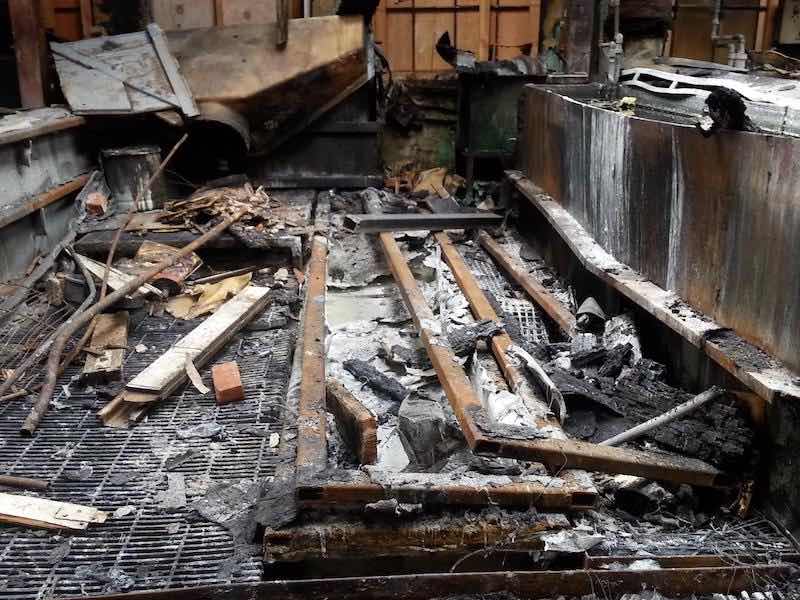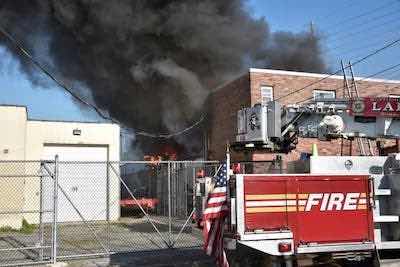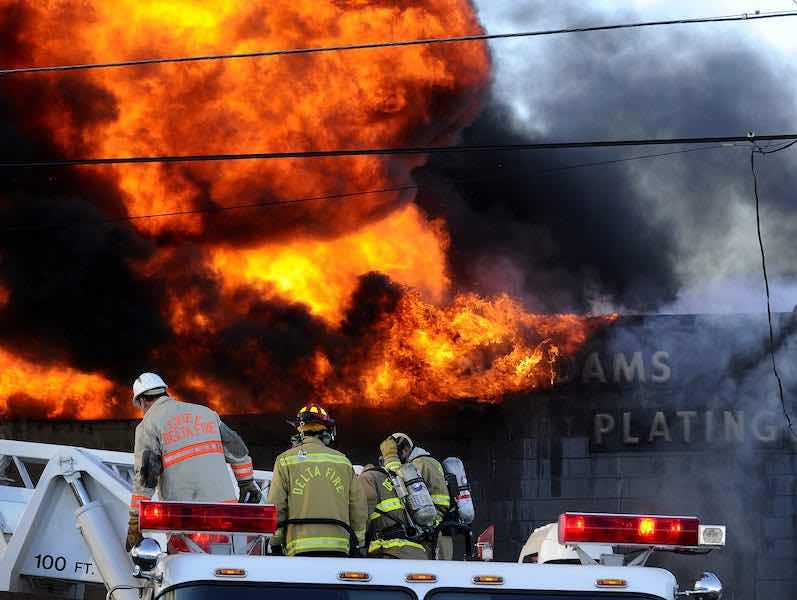When Simon Haining’s finishing operation at High Tech Finishing caught fire in May, he didn’t need to wait for an investigation to see what caused the disaster.
 Simon Haining“We have cameras in the facility, and one of them was looking right at it when the fire started,” says Haining, president of the Houston shop. “It was a particular hearing element that was at fault. We don’t know exactly what the fault was; that’s still to be determined.”
Simon Haining“We have cameras in the facility, and one of them was looking right at it when the fire started,” says Haining, president of the Houston shop. “It was a particular hearing element that was at fault. We don’t know exactly what the fault was; that’s still to be determined.”
The fire at High Tech Finishing is one that has plagued the finishing industry for several decades. The fires are often the result of something electrical, and they usually happen after hours when employees are gone for the day; the fire will smolder and then rage, often unnoticed by alarms until it is too late.
Haining says the tank where the fire began needs to be kept heated and has a heating element with a thermostat that kicks on and off to keep it at the right temperature. It appears the device malfunctioned and somehow caused the fire, he says.
 in May, High Tech had an overnight electrical fire — traced to a heating element in a tank — that disabled about 75% of the operations of the facility.It also appears to be a trend that Haining unfortunately learned about too late.
in May, High Tech had an overnight electrical fire — traced to a heating element in a tank — that disabled about 75% of the operations of the facility.It also appears to be a trend that Haining unfortunately learned about too late.
“I’ve spoken to five different plating shops in the last week, and every one of the five has had a fire like this,” he says. “Four of them for the same reason, which was a bad eating element. It seems like it’s a common problem. One is not necessarily a pattern. Two make it a coincidence. Three is definitely something to look at. But four? That’s a common denominator.”
60% of Fires Caused by Electric Immersion Heaters
There are no official statistics on the causes of plating shop fires, which usually happen to several shops each year. But many shop owners believe it is electrical, and usually is tank side.
A study done by a major insurance carrier several years ago found over 60% of all fires in electroplating shops were caused by electric immersion heaters. The study found some were left energized during idle periods or were activated by a timer several hours before the beginning of operations.
In Germany — where roughly 80 fires occur at plating shops each year — the estimate is that over 70% of fires are caused by heating rods or some other type of electrical malfunction.
“That would be why Anoplate is 100% steam heat. Yes, the coils and heat exchangers take up space, but steam doesn’t lead to fires.”
The large number of fires caused by electrical components near the plating lines has forced some shops to move away from equipment that might eventually malfunction in the often-corrosive environment.
 Milt Stevenson Jr.“That would be why Anoplate is 100% steam heat,” says Milt Stevenson Jr., Vice President and Chief Technology and Environmental Officer at the Syracuse, New York, surface finisher.
Milt Stevenson Jr.“That would be why Anoplate is 100% steam heat,” says Milt Stevenson Jr., Vice President and Chief Technology and Environmental Officer at the Syracuse, New York, surface finisher.
“Yes, the coils and heat exchangers take up space,” he says. “But steam doesn’t lead to fires.”
HDI Risk Consulting, a German company that supports major companies with loss prevention and in establishing risk management systems, says its research shows that of losses in electroplating plants — which are mainly characterized by fires, explosions, and releases of hazardous substances — about 43% results from fires, with 37% from releases of substances, and 20% from explosions.
“Technical defects, at 40%, are the most frequent origin of losses,” the company says. “More than 30% of the losses are attributable to human error and frequently due to incorrect operation.”
Unfortunately, HDI Risk Consulting says the origin of what causes the fires remains unrevealed in roughly 25% of the events, which is mostly due to destruction following the loss. But they say extensive electric installations frequently constitute the ignition sources in electroplating plants:
- Electric heaters in the electrolyte and pretreatment tanks;
- Mechanically and/or chemically loaded electric cables;
- Electric overload of DC cables due to corrosion-induced reduction of line cross sections.
The list of recent shop fires has been numerous, although often the determination of the cause of the fire can not be determined. Some, however, have been directly related to heaters or other electrical components that have malfunctioned.
Growing List of Shop Fires
 Highlands Plating in Los Angeles was destroyed by a fire caused by an electrical short.Aside from the High Tech Finishing fire in Houston in May, numerous other major fires have taken place at plating and anodizing shops over the last few years and decade:
Highlands Plating in Los Angeles was destroyed by a fire caused by an electrical short.Aside from the High Tech Finishing fire in Houston in May, numerous other major fires have taken place at plating and anodizing shops over the last few years and decade:
- 2023: High Tech Finishing in Houston burns on a weekend after in May when a faulty heating element in a tank caused enough damage to disable about 75% of the operations of the facility. Working night and day, the team got operations back running within 36 days.
- 2023: J&M Plating in Rockford, Illinois, suffered damage in July when two heat-treating units caught on fire, officials say. Embers from the first fire sparked another fire on the roof a few hours later, causing even more damage.
- 2023: CRC Chrome in Meriden, Connecticut, caught fire on a Friday in May that caused a 6-alarm response. The same facility caught fire in 2021 with a flash fire when officials say employees dumped lacquer into a heated rinse tank.
- 2022: J&S Plating in Farmersville, Texas, saw a fire started shortly after 5:00 a.m. Damage to the back of the one-story metal structure was extensive, and the fire was completely extinguished about three hours later.
- 2022: Alert Plating Co. in Sun Valley, California, was damaged by a fire that started in a container at a metal plating facility. Authorities said the damage was held in check by the structure’s fire sprinkler system.
- 2021: Mechanical Galv-Plating Corp. in Sidney, Ohio, has a fire start at 5:00 a.m. on a Saturday morning after being shut down all week for the Thanksgiving holiday. The origin was traced to the rear of the business at a metal coating application process work area.
- 2021: Diamond Chrome Plating in Howell, Michigan, suffered significant damage from a fire that was believed to have started in the ventilation scrubbers located on the building’s roof.
- 2020: The roof at Tronic Plating in Farmingdale, New York, collapsed after a fire broke out around 5:00 p.m. on a Friday, with 14 fire departments responding with roughly 150 firefighters to extinguish the flames.
- 2020: Officials say an “electrical malfunction” caused a fire at Kuntz Electroplating in Kitchener, Ontario, Canada. The fire caused about $100,000 in damage.
- 2020: Jagemann Plating in Manitowoc, Wisconsin, had a fire start at 3:30 a.m. Crews were able to advance and extinguish the blaze within 35 minutes.
- 2019: Fire broke out around 4:00 a.m. at Eagle Plating in Providence, Rhode Island.
- 2019: Arlington Plating Company in Palatine, Illinois, suffered a fire around 11:00 p.m. The shop’s sprinkler system doused much of the fire, as workers were still in the building. The cause was undetermined.
- 2018: Advanced Plating in East Nashville, Tennessee, had an electrical fire start on a Saturday afternoon. Half of the building was lost in the fire, its second in several years as well as a flood that destroyed much of the property too. A 1997 fire caused $2 million in damages, and a 1999 tank fire caused another $1 million. In 2010, a flood caused a $3 million loss. The company then moves to Portland, TN.
- 2017: Protech Metal Finishing’s facility in Vonore, Tennessee, was heavily damaged by fire around 11:00 p.m. after hours, and fire officials determined an oven motor overheated. Officials say it was the third fire at the facility in the last several years.
- 2015: Technical Metal Finishing in Burbank was purchased by Nasmyth Group, which added 18,000 square feet to the existing 10,000 sf, but the facility caught fire through an electrical short and heavily damaged half of the facility. They eventually moved to northern Los Angeles and opened a new facility.
- 2015: A fire began at around 3:30 a.m. at Sun Glo Industrial Plating in Clearwater, Florida, destroying most of the 19 plating lines at the facility. The damage took out 40% of their entire finishing operation.
- 2014: The Asko Group in Seattle reported a fire just before 1:00 p.m. that took nearly 10 hours to extinguish. Employers reported an electrical fire that sparked nearby oil that spread the fire rapidly. The damage was in the millions of dollars, fire officials said at the time.
- 2013: Sparks from a welder started a fire in the ventilation system of Kuntz Electroplating in Kitchener, Ontario, Canada. Crews from Kuntz’s in-house emergency response team were already attacking the flames when firefighters arrived.
- 2013: Burton Metal Finishing in Columbus, Ohio, suffered a major fire after hours after it was suspected an employee tossed a cigarette into the compressor room trash. A family-owned company, it took Burton almost two years to get things built back up, but the new features are an automated and computerized control system that checks each part as it progresses through the line.
- 2013: Aero Chrome Plating in Panorama City, California, caught fire at around 3:30 a.m. Aero owner Gary Berger says his same business caught fire at a different location several years earlier.
- 2009: Westfield Electroplating in Massachusetts suffered about $1 million in damage when a fire broke out on a Sunday when employees were gone, destroying four of its tanks. Fire officials suspected that the origin was electrical.
- 2009: An electrical short sparked a blaze in the corner of Morrell’s Aerospace in Los Angeles, leading to the complete loss of the roof. The fire started in an area that was a paint shop for the finishing company.
- 2006: Fire breaks out at 3:30 a.m. at Reliable Plating in Chicago, damaging 70% of their finishing operations and all of their wastewater treatment system. The cause of the fire was never officially determined, but owners suspected a heater may have sparked the blaze. It took nearly to get their facility back running.
- 2005: Precious Plate in Niagara Falls, New York, suffered a blaze that destroyed more than half of the company’s 65,000 square feet. The fire broke out in the west end of the building in an addition that was just five years old. Fire officials suspected it started with a heating element.
- 2005: Atlas Plating in Cleveland had just been purchased by neighboring SpringCo Metal Coating when a fire destroyed a majority of the facility. The fire started on a Saturday night in the main electrical connection box where the service comes into the building. SpringCo eventually rebuilt the facility.
- 2003: Electro-Spec in Franklin, Indiana, suffered a devastating fire that destroyed the entire facility. Owner Jeff Smith decided that it was time to reinvent the company and invested millions of dollars in new equipment and automation to build a new plating facility.
Some of the electrical hazards in shops may be associated with pumps, filters, blowers, heaters, grinding and buffing machines, and hand-held electrical tools.
European Countries Take Action to Curb Plating Shop Fires
In Germany, the country typically sees between 70 and 80 fires occur each year in electroplating plants, according to the German Insurance Group GDV. About 15 of those are what they term “major damage losses” that exceed close to $700,000 each year, or roughly 600,000 euros.
The GDV says that the culprit in many of these fires is the heating rods becoming too hot and causing a spark.
“Most of the incidents relate to electrical causes and, more specifically, the use of electricity for process heating in plastic or plastic-lined tanks.”
“Such damage adds up to over 70% in numbers and over 90% in loss value of all incidents under investigation,” the group says.
In Great Britain, a series of 22 major plating and anodizing shop fires over a 7-year period several years ago led the British government’s Health and Safety Executive (HSE) — the national regulator for workplace health and safety — to look into the safety of finishing operations and ways to prevent them.
 The Asko Group in Seattle reported a fire just before 1:00 p.m. that took nearly 10 hours to extinguish. “Most of the incidents relate to electrical causes and, more specifically, the use of electricity for process heating in plastic or plastic-lined tanks,” the HSE reported. “Such fires have frequently spread to plastic/fiberglass extraction hoods, ducting and related equipment.
The Asko Group in Seattle reported a fire just before 1:00 p.m. that took nearly 10 hours to extinguish. “Most of the incidents relate to electrical causes and, more specifically, the use of electricity for process heating in plastic or plastic-lined tanks,” the HSE reported. “Such fires have frequently spread to plastic/fiberglass extraction hoods, ducting and related equipment.
HSE reported that they found six key factors in preventing electrical fires in plating and anodizing shops:
- The proper selection of equipment.
- The installation and positioning of heaters.
- The arrangement and integrity of control and sensor circuits; and
- The subsequent effective maintenance of the system.
The British Surface Treatment Suppliers Association (BSTSA) and the Loss Prevention Council published a new Code of Practice that calls for a number of key requirements for fire safety. A few in particular specified:
- Firm and suitable fixing of the heater with defined clearances.
- Automatic fluid make-up to maintain the process’s liquid level.
- A low-level cut-out in the event of catastrophic loss of process fluid.
- Built-in overtemperature device for the heater (preferred option); and
- Effective maintenance of controls by regular logged inspection and testing procedures.
“Perhaps a more fundamental answer to the fire risk is a move away from direct immersion heating to indirect heating using heat exchangers,” the HSE says in its report. “This has two clear advantages: the heating element can be well earthed and does not become plated or salted-up; and in the event of a fault developing, any subsequent overheating would occur in the heat exchanger rather than the plastic tank.”
Polypropylene Plastic Tanks and Ducts Add To Fire Concern
 FM Global, a US mutual insurance company based in Rhode Island, prepared a case study of a recent major fire at a machining shop that also had an in-house electroplating operation. The fire caused about $24 million in damage and was traced back to equipment in a plating line.
FM Global, a US mutual insurance company based in Rhode Island, prepared a case study of a recent major fire at a machining shop that also had an in-house electroplating operation. The fire caused about $24 million in damage and was traced back to equipment in a plating line.
“A poorly tightened electrical bus bar connection is believed to have caused excessive resistance heating which, in turn, ignited a plastic tank in the electroplating department of this manufacturing plant,” FMG’s report said. “The fire spread quickly throughout the electroplating department and damaged both the building and production machinery beyond repair.”
Following the fire, FMG says all plating operations onsite ceased for approximately 14 months while the plant was reconstructed. During this time, plating work had to be outsourced to other client facilities and to external suppliers.
FMG says the use of polypropylene plastic tanks and ducts — which have little resistance to fire spread and a high heat release — was a major negative factor in the fire, as was additional plastic enclosures around the plating lines that added to the overall combustible loading and created vertical surfaces for fire to spread.
Allianz Global Corporate and Specialty (AGCS), a top global corporate insurance carrier, puts much of the blame on electroplating fires on the heated plastic or plastic-lined tanks.
“Plastics most commonly used, such as polypropylene, polyethylene, polyvinyl chloride (PVC) and fiberglass reinforced plastic, have excellent corrosion resistant properties; however, they are highly combustible and tank heaters can present an ignition source,” says Wilson Liu, Technical Manager Asia for Allianz Risk Consulting.
Becoming a ‘Significant Fire Hazard’
“Without proper protection and maintenance, heated plastic tank operations can become a significant fire hazard,” Liu says. “Fires involving the tank often spread to associated plastic piping and ductwork used for fume removal and surrounding areas.”
“Electric immersion heaters, which are typically submerged in the processing solution, were responsible for 61% of the losses.”
Allianz began warning platers and anodizers of the hazards after another global property insurance company reported that during the period from 1985 to 1999, they experienced 52 losses involving plastic and plastic-lined tanks in occupancies involving metal plating, circuit board manufacturing/assembly and semiconductor manufacturing.
“Electric immersion heaters, which are typically submerged in the processing solution, were responsible for 61% of the losses,” Liu says. “Most fires occurred when heaters were either left on during idle periods or were activated by a timer several hours before the beginning of operations.”
The company says that malfunctioning low-liquid level interlocks and/ or high-temperature limit switches were a major factor in most losses.
“Also, interlocks were often poorly maintained and did not function properly,” Liu says.
Insurers Issue Warnings and Recommendations
 The roof at Tronic Plating in Farmingdale, New York, collapsed after a fire broke out around 5:00 p.m. on a Friday.The dangers of fires in plating shops propelled Allianz to issue several warnings and recommendations to its customers in the finishing industry. They said following basic loss prevention guidelines can greatly reduce the potential for property damage and resulting business interruption caused by heated plastic tank fires:
The roof at Tronic Plating in Farmingdale, New York, collapsed after a fire broke out around 5:00 p.m. on a Friday.The dangers of fires in plating shops propelled Allianz to issue several warnings and recommendations to its customers in the finishing industry. They said following basic loss prevention guidelines can greatly reduce the potential for property damage and resulting business interruption caused by heated plastic tank fires:
- If possible, use tanks constructed of noncombustible materials (i.e., stainless steel, quartz, etc.). If plastic materials are required, use plastics that are FM Global Research Listed (Class 4910 Standard) or equivalent.
- Use the following type of heaters, listed in order of preference:
- External heat exchangers using hot water or steam
- Low watt density electric immersion heaters (1.3-1.6W/cm2(8-10 W/in2))
- Ordinary (high watt density) electric immersion heaters
- Interlock electric immersion heaters to automatically activate a local alarm and de-energize upon:
- Low liquid level when any portion of heater element is exposed
- High liquid temperature at 15°C (25°F) above normal operating temperature. Note: do not rely on heater thermostats
- Shut off heaters during idle or unoccupied periods. Do not use timers to turn heaters on/off during unoccupied periods.
- Inspect, test, and maintain heater controls and interlocks at least quarterly in accordance with the manufacturer’s recommendations (more often if design and service conditions warrant). An ideal time is when refilling or draining the tank.
- Establish a detailed maintenance and testing record-keeping system. Conduct annual infrared inspections of all heater control boxes and electrical supply wires back to the main control panel to check for hot spots or loose connections. Any deficiencies should be corrected immediately.
- Discourage operators from operating heaters when any of the safety equipment is out of order.
- Provide automatic sprinkler protection designed to the latest edition of NFPA 13, Standard for the Installation of Sprinkler Systems, using corrosion-resistant sprinklers over tank areas and inside plastic ducts greater than or equal to 515 cm2(80 in2) cross-sectional area or 250 mm (10 in.) diameter. If contamination of tank contents is a concern, provide automatic carbon dioxide or clean agent fire protection.
- Provide proper training to all operators on the hazard and function of heaters with refresher training at least annually.
- Perform a hazard process evaluation for each new heated plastic or plastic-lined tank or any modifications to any existing tanks.
What to Check on at Your Shop
 HDI Risk Consulting says that in view of the particular ambient conditions of most shops, accelerated aging of the operational equipment must be expected. For this reason, they say maintenance, preventative maintenance, and housekeeping are particularly important. A few of the areas the company recommends that shops place close attention to:
HDI Risk Consulting says that in view of the particular ambient conditions of most shops, accelerated aging of the operational equipment must be expected. For this reason, they say maintenance, preventative maintenance, and housekeeping are particularly important. A few of the areas the company recommends that shops place close attention to:
Electrical Systems
- The safety-relevant equipment and apparatus, as well as the connections of lines/cables/electrodes (on the DC side), must be inspected at weekly intervals. Any existing oxide layers must be removed.
- To enable early detection of hot spots, especially at the DC circuit terminal connections, thermographic inspections must be carried out by a designated thermographic expert, which has to be qualified in compliance with the ISO 9712 “Non-destructive testing - Qualification of NDT personnel” standard. Experts must to be reached at least level 2 of ISO 9712 and must have skills in the construction and design of electrical installations for conducting infrared thermographic testing at electrical installations. All thermo- graphic inspections have to be reported and documented; the inspection interval has to be conducted at least every 6 months.
- A shorter monitoring interval is necessary for highly flexible electrical cables caused by the mechanical load they are exposed to during operation. Thermographic inspections of these cables must be carried out once a month.
- The inspections, including the revealed and removed shortcomings, must be documented in a shift log or operations log. If shortcomings cannot be removed immediately, repairs must be scheduled within a short time.
- Mobile electric equipment must be visually inspected at regular (e.g., 6-monthly) intervals.
Fire Protection Equipment
- The proper function of fixed fire protection equipment, such as fire extinguishing and fire alarm systems, as well as smoke and heat ventilation systems, must be ensured.
- Fixed fire protection systems must be serviced by the installation company at regular intervals. The maintenance intervals must be adapted to the corrosive ambient conditions and should not exceed one year.
- Fixed fire protection systems must be inspected at regular intervals, preferably annually.
Operational Safety
- Storage of solid and liquid hazardous materials and especially of those marked as easily flammable, flammable, and favoring a fire (F and O) in the quantities required for one day, should be in ventilated safety cabinets with a fire rating of at least 90 minutes.
- Adapted cleaning intervals should keep all operating equipment free of incrustations and/or lubricant films.
- Regular training and instructions of operating personnel regarding safety precautions and measures in case of a technical accident or fire.
- A suitably qualified fire protection officer must be nominated.
- The use of private electric appliances, such as radios, refrigerators, water heaters, etc., should be banned in electroplating areas.
- Unattended operation of electroplating plants and supply units must be avoided as a basic rule. This, in particular, refers to the automatic operation of the bath heater outside of operating hours. If operating the bath heater outside of operating hours is necessary for process and/or quality reasons, indirect bath heating is particularly recommended.
Manual Fire Fighting
- Hose reels and portable fire extinguishers must be made available for manual fire fighting by their own personnel. The use of powder-type fire extinguishers must be generally banned because uncontrolled reactions of the powder with electrolyte components cannot be excluded.
- Foam-type fire extinguishers should be provided as a general rule. In areas where electrical systems are installed, these should be supplemented by CO2fire extinguishers.
- The employees must be instructed and trained in how to handle fire extinguishers and hose reels at regular intervals.



































